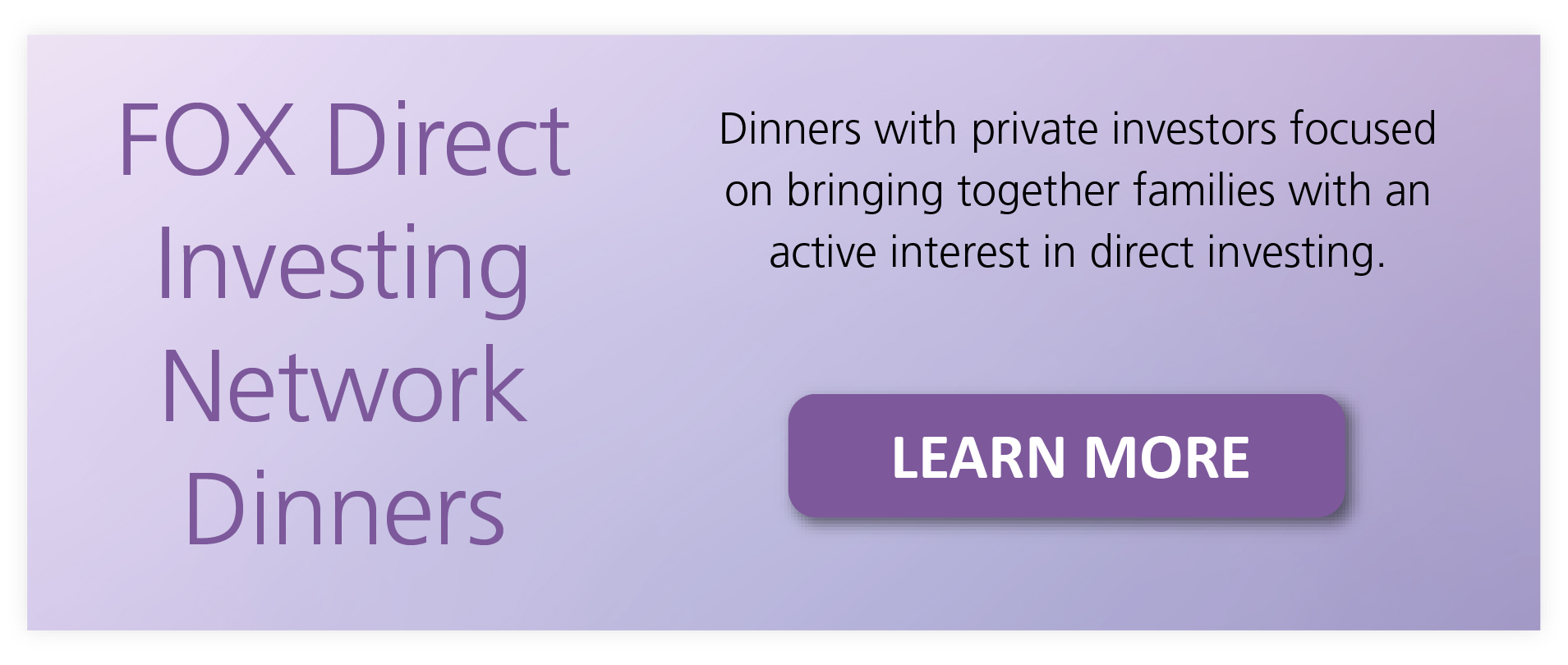FOXCast: Private Equity Fund and Direct Investing in Today's Market

In this episode, Todd Kellerman and Tim Wray, cofounders of V3 Limited, discuss lessons learned from the past and offer some insight into current family office investment trends. Todd and Tim are now focused on working with financially successful families to align investments with values and take advantage of direct investing opportunities.
V3 Limited sponsors the FOX Direct Investing Network.
Subscribe to FOXCast on Apple Podcasts here.
Listen Now: Private Equity Fund and Direct Investing in Today's Market | |
 | |
Below is a transcript from the conversation:
KC: Todd and Tim, thanks so much to you both for joining me.
Tim Wray: Thank you, KC, appreciate it.
Todd Kellerman: Thank you, KC, great to be here.
KC: Start by telling me about V3 Limited and a little bit about yourselves.
TW: It's Tim Wray here. V3 was really born out of the post-2008 crisis. We began serving family offices and ultra-high net worth clients whose private equity portfolios were facing a range of problems. And, as we all know how serious the ’08 crisis was, that ranged from operating management, to stress issues, economic and industry challenges, to those zombie and orphan funds that we're all aware of. And we were able, from the post-2008 until about 2017, to generate some very meaningful recoveries and returns for investors that were facing some challenges.
We focus solely on the private equity industry. We have an expertise on private equity funds, both sitting on the management side, as well as representing investors. And dealing with direct investments which have become a big portion of clients’ portfolios today. And the reason that V3 has stayed focused on this is really three main reasons: (1) In looking at all the data with private equity over the past 20 years, about a quarter or at least a quarter of all private equity investments face trouble—whether you're in VC, buyouts, real estate, or debt. It's just the nature of the industry. (2) And unlike fixed income and public equities, the range between top-quartile and bottom-quartile is dramatic. Top quartile performances in private equity are 20%, 30%, 40% returns, while bottom quartile can be negative. You cannot get all your invested capital back, compared to a fixed income that rates 100, 200, 300 basis points. (3) So, what we bring as individuals to V3, is both of us each have about 20 years of experience in the private equity industry. Like I said, we've worked for funds, we’ve worked in all C-suite roles—CEOs, CFOs, COOs. We've represented investors on limited-partner advisory committees. We've really been in basically every position and every seat at the table when it comes to private equity.
KC: So, moving now to 2019—how would you describe the state of the market for private investors?
TW: Well, I'm sure all those that are focused on the private equity space know of what we're seeing in the headlines. Everyone is aware, across all these segments, that in buyout and real estate we're seeing valuations back to their sort of all-time-high levels that we saw pre-’08. We're also seeing leverage on deals, especially in the buyout space, again, back to all-time-highs, as far as the amount of leverage that was being put on companies.
What really is interesting, and we're not hearing that that much about, is the capital-raise and acquisition levels have remained at last year's rate. We're seeing a lot of capital being raised, we're seeing a lot of acquisition deals. But what's interesting about 2019 and where we sit specifically today, is that the amount of exits and realizations for ’19 are down about 30% to 40% from last year. And I think that may be an indication of where the trends in the market are occurring.
What we really don’t talk about a lot is, number one, in this debt segment, 20 to 25 years ago, all the debt that was used for private equity acquisitions was bank debt. We knew how banks operated, we knew workouts, we know exactly how they structured these things. I think most people are aware that basically banks are gone from the private equity industry now. And that all leverage and lending that is used in these deals now comes from private lenders. And we hear things like “covenant light,” and we think this is a dramatic change in the nature of the players. And I think as we go forward, it will be interesting to see, when trouble occurs or when there's blips in company performance, we’re just not sure how some of these these lenders are going to react and deal with the private equity investors.
The other big piece we're seeing is really the longer hold periods. One of the reasons we really love the family office space is that it is patient capital. And families can really gear the nature of their investments to the right timeline that they're focusing on for the companies. But we think, also, longer timelines really require some attention to detail. Because you have to be watching how how quickly your value creation is going for these longer 10 to 15 year hold periods if you're really generating the kind of value you need.
The other big trend that I don't think people talk about a lot is just the size of the market. The fact that because there are so many private equity funds out there, because there are so many options that investors have, because investors—and we're especially seeing this in the family office space—have gotten much smarter, much more savvy about allocating their capital. LPs and investors are really able to demand more rights, more transparency—more rights as far as the performance of the GPs. And we think this is a really good benefit for the family office space. Whereas 30 years ago, you just kind of hope you got accepted into funds and you kind of played along with whatever you were given. I think now, limited partners really have the ability to make sure they're investing in exactly the right way with the right kind of relationship with the general partner.
KC: That’s great. Are you seeing any change in how family offices are making their private investments?
TK: KC, this is Todd it's a great question. We definitely do. And we are seeing, certainly, an increase in families allocation. So, they're increasing the percentage of capital that they're earmarking towards private investments. And they're able to now customize more about what they want. And so, Tim was speaking about "patient capital." Families have very specific values that they focus on and they're able to align their investment strategy more with their personal beliefs—and more with the values that they've created within their family, typically, over many generations.
And so, you know, there's a big movement in impact investing and a big movement for these specific opportunities, around maybe opportunity zones. But just because the universe of opportunities has increased and the families have started to evolve and share more information amongst each other, there's just much more opportunity. The opportunity set has increased.
And families have become much more sophisticated. You know, rather than having one person or two people just make investments based on their own personal networks, families are setting up their own, really professional, private equity or private investment shops inside. And so, they’re doing all the things that some of the other professionals are doing on the outside. And so, there's been a real movement in terms of the level sophistication that families are pursuing within the private space.
KC: Can you, for people who may not know, or have heard before but are not really sure what it is, what are “opportunity zones?”
TK: Oh, sure. So, there's always these different investment opportunities that come along that are driven, maybe, by tax incentives. So, the opportunity zone is just a tax incentive that allows families to possibly defer gains that they have. Many families have created wealth through through exits and have very low basis positions, and have embedded capital gains. And so, there was legislation that came out a couple of years ago, and now there's more regulations that are helping inform investors more fully—where you can defer and even maybe eliminate a portion of those embedded gains.
And so, these are trends that we see. Twenty years ago, there were other things that have come along. It's a hot area. It's just one of these things that families really are are seeing and getting inundated with all of these opportunities. But the families that are really thoughtful about where they want to be investing—whether that be geographically, from a values perspective, from an investment thesis perspective, and from an expertise perspective, are really looking at it in that way. And then letting the tax side kind of inform, as opposed to just chasing a unique tax planning strategy.
There's always risk when these new things come out. You know, the pricing for these particular investments are quite high and even some of the management teams sponsoring them tend to over-price when these things come out. But it is one of those unique opportunities that families are very interested in looking at and evaluating. And we're seeing that quite a bit.
KC: You mentioned family offices maybe are becoming more sophisticated and bringing that private equity investing in-house. What does that mean for the market?
TK: It's a really good question. So, I think what you're seeing is families going through a range of businesses that they're setting up. You may have families that are going at it by themselves, you may have families that are working alongside other families.
Sometimes you'll read that families may be kind of stepping away from the more formal fund-structure or professional managers. We're really finding is that families are just trying to figure out who the best people to work with are. And many times that still is general partners but it may just be in different structures where they're able to customize something in some kind of side-by-side or coinvest. And so, families are certainly becoming a deal-flow source that they're sharing with professional investors and vice versa. Some families are kind of going it alone. But I think, generally what we're finding, is that the families that are doing this well, are looking to invest with the right people. And many times, that's still involving some of the traditional fund-structures that are out there.
We are also seeing, on the sophistication front, families setting up GP and LP structures within. So, the same kind of incentives within the family and and the same type of structural things that professional investors do, families are doing that inside—which brings in just a whole need for a certain level of expertise to understand how to do that and set it up set it up correctly.
KC: Yeah. And then, what are some of the risks for this type of investor?
TK: Tim really spoke about timeline and and this concept of “patient capital” and that's a big advantage that families have. But it also can be a big disadvantage. When you're investing as a private investor and you're investing over a long period of time, you're really building a long-term relationship with a management team or with a particular industry. And so, as time passes, what we've experienced in the work that we've done with families, things like transparency and the status of reporting sometimes will start lagging. Compensation for the management team that are running investments may not be aligned because they face challenges and they just need to be reset. So, incentives may not be aligned.
Governance within the investment oversight is critically important to maintain over time. And then, equally important—and this is something that we spend a lot of time with families on—is documenting, “what were you expecting to get out of this investment? What’s coming? What is actually happening?” And communicating the investment portfolio to the family.
And we hear about a lot of families breaking down over generations, not because of a lack of investment performance, but around communications. And so, a lot of the work that we do is just informing the larger family about what this portfolio is, what it's expected to do, and what may happen over time.
So, that's a very helpful thing we've been able to help families through—just understanding what they own and what it's worth. What type of liquidity is going to be coming from these investments over time and what their expectations should be. And knowing that this is a long-term relationship and a long time frame that they're going to be in these investments. These are not generally liquid, and so these are not the types of things that they can go out and sell at any reasonable price. So, they have to be committed to stay on-task and be very actively managing the portfolio.
KC: Looking to the future, what are some examples of what was learned in the crisis of '08 and that you can take into maybe the next downturn?
TK: Thanks, KC, this is Todd. So, the biggest lesson that we learned coming out of '08 is that it really was a crisis. And we were, all of us, really reacting to a crisis. And in private investments, initially what we found happening was that there were a lot of, call them vultures or call them buyers of assets on-the-cheap, that were coming to really try to take advantage of families. And so, that was certainly something that we learned about when the crisis happened and transparency went down, and there was uncertainty around the value of what family's investments were worth, and what the timeframe and liquidity was going to be. One of the immediate things that we really stepped in and helped the families do was to really evaluate what was going on but not make any quick decisions to get rid of assets.
And so, even if there were challenges everyone was going through that. If you had a liquidity crunch, if you will, for a family—not to really permanently damage the family's wealth but by making quick decisions. There are many times where we stepped in and said, "let's not do anything rash, let's really come up with the plan." And plans might still be a one, two, three, year plan.
We've worked many of the families out of those challenging investments over a four, five, six, seven year period. But even today, there's still some left. And we've protected a lot of value for many families and we're still extracting value. So, it's not to say that if there's a crisis, they need to make a fire sale. What we've tried to really talk to families about in this "lessons learned," is just moving from that reactive mode to a preventative mode.
To really think about, what happens if the value of these investments go down by a certain amount? What happens if the liquidity time frame, instead of you expecting a certain amount of cash to come in over one to two years, it doesn't doesn't come in for another four or five years? Some of the things we talked about earlier around really having a deliberate, diagnostic process today and looking at the portfolio. And really put a plan together that says, “here's the five year forecast of cash that I'm expecting." Two things: one, how much is coming into the portfolio? And importantly, how much will the portfolio will require? And make sure that that cash budget is established today for the family.
And so, having these kind of plans really centered around future expectations and how bad things could go, I think is one of the real things where we're really encouraging and working with families every day on to make sure that they're ready for the next downturn. And just, hopefully, it's it's not as bad. But, if it is, then they'll be ready for it.
TW: Yeah, and to add to that comment, being proactive and having these scenarios prepared and understanding what can happen, you tend to not have those emotional reactions when times are bad. It's a lot easier to react to these challenges when you already have a plan in place. You already have sort of backstops ready and you can then be more objective, more confident with exactly how you treat these investments.
What we saw post-’08 was a lot of emotional reacting and not a lot of really thoughtful, objective reacting. And those smart investors were the ones who took the step back, either had things in place, or were willing to sort of plan patiently. You felt like when the market bottomed in '09, the world's coming to an end, I've got to do something this week. What you really should be doing is putting together a plan way ahead of time and then being thoughtful. Again, you’ve got to act with a sense of urgency. But you've really got to be thorough in your analysis and preparation for the changes that come with private equity.
KC: Perfect. That's a great place to wrap it up. Thank you both so much for joining me again.

